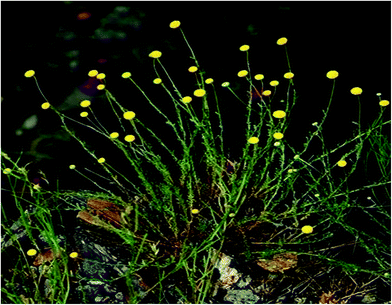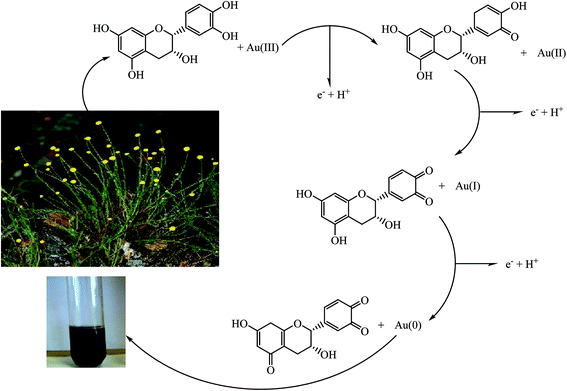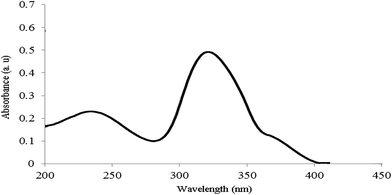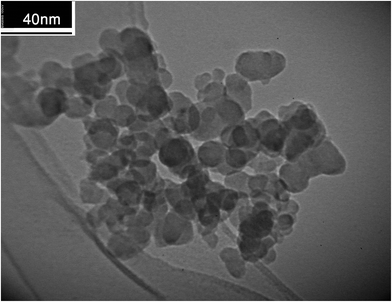Preparation of Au nanoparticles by Anthemis xylopoda flowers aqueous extract and their application for alkyne/aldehyde/amine A3-type coupling reactions
Mahmoud Nasrollahzadeh*a and
S. Mohammad Sajadib
aDepartment of Chemistry, Faculty of Science, University of Qom, Qom 37185-369, Iran. E-mail: mahmoudnasr81@gmail.com; Fax: +98 25 32103595; Tel: +98 25 32850953
bDepartment of Petroleum Geoscience, Faculty of Science, Soran University, PO Box 624, Soran, Kurdistan Regional Government, Iraq
First published on 18th May 2015
Abstract
This paper reports on the green synthesis of gold nanoparticles (Au NPs) by Anthemis xylopoda flowers aqueous extract without the addition of surfactant agents and their application as stable catalysts for propargylamines through one-pot three-component condensation reaction of aldehydes, amines, and alkynes. FT-IR, UV-vis spectroscopy and transmission electron microscopy (TEM) are used for the characterization of Au NPs. Polyphenolics are believed to play an important role in Au NPs biosynthesis through the reduction of gold ions. This method provides high yields and easy work up. In comparison with homogeneous and traditional heterogeneous catalysts, metallic NPs display greater catalytic activity due to the increased metal surface area and require less metal to be used in catalysis. Also, in every case, the Au NPs could be easily recovered and reused several times, and at the end of the process, the product was metal-free.
1. Introduction
Propargylamines are major skeletons and synthetically key intermediates in the synthesis of various natural products and therapeutic drug molecules.1Traditionally these compounds are prepared by nucleophilic attack of lithium acetylides or Grignard reagents on imines or their derivatives in the presence of homogeneous palladium complexes with coordinating phosphine or other ligands in toxic organic solvents.2 These reagents are highly moisture sensitive and used in stoichiometric amounts. There are alternative processes for synthesis of propargylamines by three component one-pot coupling reaction (A3 coupling) of aldehydes, alkynes and amines in the presence of homogeneous and heterogeneous catalysts such as Ag(I) salts,3a Au(III) salen complexes,3b Cu(I) salts,3c Cu–Ru bimetallic system,3d heteropolyacid-supported silver (Ag-HPA),3e hydroxyapatite-supported copper (Cu-HAP),3f AgY zeolite in water or organic solvents.3g The available method for preparation of propargylamines in water is limited for cyclic amines.4 The problem with homogeneous catalysis is the difficulty to separate the catalyst and the impossibility to reuse it in consecutive reactions. In order to solve the problem, alternative environmentally benign processes for the recovery of catalyst should be developed.
Due to high surface-to-volume ratio and nanoparticles highly active surface, heterogeneous catalysts are more and more used in the form of nanoparticles.5 Additionally, nanocatalysis can make the products easily removable from the reaction mixtures and make the catalysts recyclable.5 Among various metallic nanoparticles, gold nanoparticles (Au NPs) have been used widely in recent years due to their broad applicability in biomedicine, catalysis, and biosensing.6 The use of Au NPs allows “ligand-free” synthesis, which reduces costs, simplifies work-up procedures, and facilitates the separation of the final product. It is found that Au NPs are effective catalysts for some chemical transformations in organic solvent the catalysis occurs on the Au surface.7 However, Au NPs require more complex production methods which often imply the use of toxic and hazardous reagents.8 Therefore, the development of newer, economic and eco-friendly techniques for the synthesis of Au NPs is very desirable.
Green synthesis of NPs by plants extract and trees gum has been studied in the recent two decays.9 Formation of metal NPs by plants extract is one of convenient, simple and clean methods to produce these particles. Green synthesis of nanoparticles makes use of environmental friendly, non-toxic and safe reagents. Indeed green synthesis of metal NPs, in contrast to chemical and physical methods, can be performed in a clean, well-controlled environment, such as water, giving to rise production of pure nanomaterials. Recently, our group has successfully demonstrated the rapid synthesis of metal NPs using plants extract or trees gum.9 The major advantage of using extracts is that they are the mild, renewable and non-toxic reducing and stabilizing agents, eliminating the need for chemical reducing agents such as sodium borohydride and expensive polymeric capping agents and stabilizers.
The genus Anthemis xylopoda (Fig. 1) belongs to the family Asteraceae (Compositae), is a multi-branched aromatic annual herbs that spread quickly native to northern Europe and West Asia The species of the Anthemis genus are widely used in the pharmaceutics, cosmetics and food industry.10 The flowers of the genus have well-documented use as antiseptic and healing herbs because of its natural phenolics and essential oils content.10
As part of our ongoing interest in heterogeneous nanocatalysts,11 we now wish to report a facile and effective route for preparation of Au NPs by Anthemis xylopoda flowers aqueous extract without using any other capping agent. Furthermore, the catalytic efficiencies of Au NPs were evaluated by A3-coupling reaction of aldehydes, amines and alkynes via C–H activation. To date, there is no report on the green synthesis of Au NPs by utilizing the Anthemis xylopoda flowers aqueous extract.
2. Experimental
2.1. Instruments and reagents
All reagents were purchased from the Merck and Aldrich chemical companies and used without further purification. Products were characterized by comparison of their physical and spectral data with authentic samples. The NMR spectra were recorded in DMSO. 1H NMR spectra were recorded on a Bruker Avance DRX 400 MHz instruments. The chemical shifts (δ) are reported in ppm relative to the TMS as an internal standard and J values are given in Hz. 13C NMR spectra were recorded at 100 MHz. FT-IR (KBr) spectra were recorded on a Perkin-Elmer 781 spectrophotometer. Melting points were taken in open capillary tubes with a BUCHI 510 melting point apparatus and were uncorrected. The purity determination of the substrates and reaction monitoring were accomplished by TLC on silica gel PolyGram SILG/UV254 plates or by a Shimadzu Gas Chromatograph (GC-10A) instrument with a flame ionization detector using a column of 15% carbowax 20 M chromosorb-w acid washed 60–80 mesh. Column chromatography was carried out on short columns of silica gel 60 (70–230 mesh) in glass columns (2–3 cm diameter), using 15–30 grams of silica gel per gram of crude mixture. Transmission Electron Microscopy (TEM) by Philips EM208S transmission electron microscope operating at an acceleration voltage of 100 kV. The UV-visible measurements were performed at room temperature by a Perkin Elmer 550ES.2.2. Preparation of Anthemis xylopoda flowers extract
50 g of dried aerial parts of Anthemis xylopoda flowers was powdered and refluxed at 80 °C with 300 mL of sterile distilled water for 2 h. Then the mixture was allowed to cool to room temperature and aqueous extract was easily obtained by filtration.2.3. Preparation of Au NPs
In a typical synthesis of Au NPs, 50 mL of the aqueous extract of plant flowers was added dropwise to 50 mL of well-mixed 0.003 M aqueous solution of HAuCl4 with constant stirring at 60 °C for 2 h. After 7 min the color of the solution was changed to black due to excitation of surface plasmon resonance which indicates the formation of Au nanoparticles, as monitored by UV-vis spectroscopy. The obtained solution of nanoparticles centrifuged at 6500 rpm for 30 min and obtained precipitation washed three times using absolute ethanol to remove possible impurities then air dried for 24 h at room temperature, Scheme 1.2.4. Typical procedure for the synthesis of propargylamines
To a mixture of aldehydes (1.0 mmol), amine (1.0 mmol), and alkyne (1.2 mmol) in CH3CN (5.0 mL), catalyst (10 mol%) was added and the mixture was vigorously stirred at 75 °C under a nitrogen atmosphere for the time specified in Table 2. After completion (as monitored by GC and TLC), the reaction mixture was cooled to room temperature, centrifuged and organic phase was separated, dried over anhydrous MgSO4, and evaporated under reduced pressure. The residue was purified by column chromatography on silica-gel by using n-hexane/EtOAc (15% ethyl acetate in n-hexane) as an eluent to afford propargylamine. All the products are known and the spectroscopic data (FT-IR and NMR) and melting points were consistent with those reported in the literature.12| Entry | Au NPs (mol%) | Solvent | Temperature (°C) | Time (h) | Yieldb (%) |
|---|---|---|---|---|---|
| a Reaction conditions: benzaldehyde (1.0 mmol), piperidine (1.0 mmol), phenylacetylene (1.2 mmol), solvent (5.0 mL), N2.b Yields are after work-up. | |||||
| 1 | — | CH3CN | 75 | 10 | 0 |
| 2 | 10 | THF | 75 | 5 | 89 |
| 3 | 10 | CH2Cl2 | 25 | 10 | 0 |
| 4 | 10 | Cyclohexane | 25 | 10 | 0 |
| 5 | 10 | Methanol | 75 | 5 | 94 |
| 6 | 10 | CH3CN | 75 | 5 | 97 |
| 7 | 15 | CH3CN | 75 | 5 | 97 |
| 8 | 5 | CH3CN | 75 | 5 | 87 |
| Entry | R1 | Amine | R4 | Time (h) | Yieldb (%) |
|---|---|---|---|---|---|
| a Reaction conditions: catalyst (10 mol%), aldehyde (1.0 mmol), amine (1.0 mmol), alkyne (1.2 mmol), CH3CN (5.0 mL), N2, 75 °C.b Yields are after work-up.c The yields from four subsequent runs using the same recovered catalyst. | |||||
| 1 | Ph | Piperidine | Ph | 5 | 97 (97, 96, 94, 92)c |
| 2 | Ph | Morpholine | Ph | 8 | 86 |
| 3 | Ph | Pyrrolidine | Ph | 7 | 72 |
| 4 | 4-CH3C6H4 | Piperidine | Ph | 12 | 83 |
| 5 | 4-CH3C6H4 | Morpholine | Ph | 9 | 90 |
| 6 | 4-CH3C6H4 | Pyrrolidine | Ph | 12 | 74 |
| 7 | 4-OCH3C6H4 | Piperidine | Ph | 9 | 90 |
| 8 | 4-OCH3C6H4 | Pyrrolidine | Ph | 10 | 80 |
| 9 | 4-ClC6H4 | Piperidine | Ph | 5 | 98 |
| 10 | 4-ClC6H4 | Morpholine | Ph | 7 | 94 |
| 11 | 3-ClC6H4 | Piperidine | Ph | 5 | 97 |
| 12 | 4-BrC6H4 | Piperidine | Ph | 7 | 96 |
| 13 | 4-BrC6H4 | Morpholine | Ph | 7 | 97 |
| 14 | 2-Furfuryl | Piperidine | Ph | 4 | 86 |
| 15 | 2-Furfuryl | Morpholine | Ph | 5 | 86 |
| 16 | 2-Thiophenyl | Piperidine | Ph | 5 | 94 |
| 17 | Ph | Piperidine | 4-CH3C6H4 | 7 | 90 |
| 18 | Ph | Pyrrolidine | 4-CH3C6H4 | 7 | 87 |
| 19 | Ph | Piperidine | n-Bu | 6 | 92 |
| 20 | Ph | Morpholine | n-Bu | 6 | 91 |
| 21 | 4-ClC6H4 | Piperidine | n-Bu | 6 | 91 |
| 22 | Ph | Piperidine | CH2CH2OH | 6 | 82 |
2.5. Spectral data for selected products
3. Results and discussion
3.1. Green synthesis of Au NPs in water
Compared to most investigations on the synthesis of metal NPs, which are conducted under vacuum conditions or in an inert atmosphere, the experimental setup for preparation of NPs under biosynthesis conditions is relatively simple. In our method, the Au NPs were prepared by Anthemis xylopoda flowers aqueous extract in water without using any capping agent. The main aim of the study was to develop a cost-effective and eco-friendly technique for the synthesis of Au NPs with non-extreme operational conditions from a gold salt solution. The source of palladium was HAuCl4 in distilled water. The Au NPs were characterized by a variety of standard analytical techniques such as UV-vis, FT-IR and TEM.The previous studies on Anthemis xylopoda flowers extract revealed the presence of potent antioxidant flavonoid glycosides such as luteolin glucoside, apigenin glucoside and quercetin glucoside.10 These phytochemicals can serve both as effective metal-reducing agents and as capping agents to provide a robust coating on the Au NPs in a single step.
Au NPs formation was monitored visually and by UV-visible spectroscopy. Moreover, the UV spectrum of flowers extract of the plant (Fig. 2) shows specified signals of phenolics inside the plants as the bands at λmax 325 nm (band I) due to the transition localized within the ring of cinnamoyl system; whereas the band around 240 nm (band II) is for absorbance of ring related to the π → π* transitions of benzoyl system.13 Therefore, these absorbance bands confirm the presence of phenolics and ability of plant extract for green synthesis of nanoparticles.
The reaction of Au nanoparticles was completed after 7 min following the formation of nanoparticles monitored by UV-vis spectroscopy, Fig. 3. The Au NPs showed a characteristic peak centered at 535 nm indicating the surface plasmon absorption of nanosized Au particles and formation of nanoparticles. Furthermore, the stability of Au NPs was monitored by UV-vis spectroscopy at the times ranging 5 min to 30 days, the synthesized gold nanoparticles by this method are quite stable with no significant variance in the shape, position and symmetry of the absorption peak even after one month.
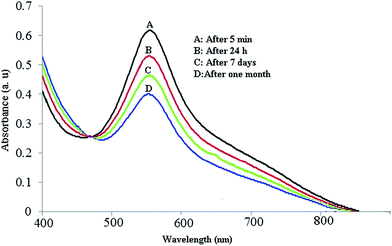 | ||
| Fig. 3 UV-vis spectrum of green synthesized Au NPs using aqueous extract of Anthemis xylopoda flowers ranging 5 min to 30 days. | ||
Beside the reports on Anthemis xylopoda flowers for detection the phytoconstituents inside the plant extract, for more convenience the FT-IR analysis was carried out to demonstrate the responsible phytochemicals during the green synthesized of Au NPs. The FT-IR spectrum of the crude extract, (Fig. 4A) depicted some peaks at 3420 cm−1, 2925 cm−1, 1687 cm−1 and 1432 cm−1 which represent free OH in molecule and OH group forming hydrogen bonds, saturated hydrocarbons (Csp3–H), carbonyl group (C![[double bond, length as m-dash]](https://www.rsc.org/images/entities/char_e001.gif) O) and stretching C
O) and stretching C![[double bond, length as m-dash]](https://www.rsc.org/images/entities/char_e001.gif) C aromatic ring, respectively. Because of presence these functional groups inside the structure of antioxidant polyphenolics, the spectrum can demonstrate the presence of phenolics in the plant extract and support the results of related literatures. Furthermore, FT-IR spectrum of Au NPs is shown in Fig. 4B. The appeared bands are lattice vibrational modes indicating the functional groups of biomolecules adsorbed on nanoparticles. The broad band in 3492 cm−1 is –OH stretching bond of hydroxyl functional group. The band around 1515 cm−1 is generally attributed to the bending vibration of sp2-carbon groups for aromatic and 1715 cm−1 for carbonyl functional group.
C aromatic ring, respectively. Because of presence these functional groups inside the structure of antioxidant polyphenolics, the spectrum can demonstrate the presence of phenolics in the plant extract and support the results of related literatures. Furthermore, FT-IR spectrum of Au NPs is shown in Fig. 4B. The appeared bands are lattice vibrational modes indicating the functional groups of biomolecules adsorbed on nanoparticles. The broad band in 3492 cm−1 is –OH stretching bond of hydroxyl functional group. The band around 1515 cm−1 is generally attributed to the bending vibration of sp2-carbon groups for aromatic and 1715 cm−1 for carbonyl functional group.
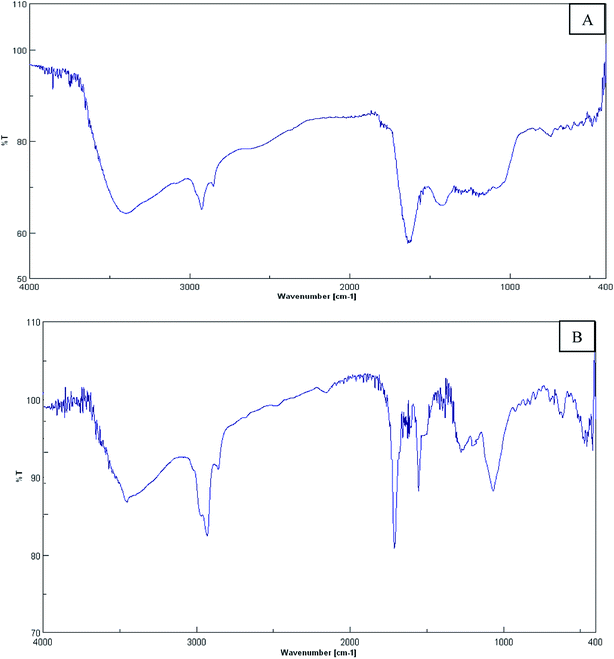 | ||
| Fig. 4 FT-IR spectra of aqueous extract of Anthemis xylopoda flowers (A) and green synthesized Au NPs (B). | ||
Morphology was investigated by transmission electron microscopy. TEM image of Au nanoparticles is presented in Fig. 5. It is observed that the particles are nanosized and approximately spherical. We observed that the prepared Au NPs was steady for several months without any agglomeration.
3.2. Catalytic activity of Au NPs in an A3-type coupling reaction for the synthesis of propargylamines
The catalytic behaviour of Au NPs was studied for the A3-coupling reaction of aldehydes, amines and alkynes to produce propargylamines. Initially, we employed benzaldehyde (1.0 mmol), piperidine (1.0 mmol), and phenylacetylene (1.2 mmol) as model substrates for the development of optimized conditions (Table 1). No reaction occurred in the absence of the catalyst (Table 1, entry 1). The results indicate that solvent significantly influence the product yield in the A3-coupling reaction. It was observed that much better yield was obtained when the reaction was carried out in acetonitrile at 70 °C compared to other solvents. To investigate the effect of the catalyst concentration, systematic studies are carried out in the presence of different amounts of the Au NPs. As shown in Table 1, the best yield is found in the presence of just 10 mol% Au NPs, and the use of higher amounts of catalyst does not improve the result to an appreciable extent. The use of lower catalyst loadings resulted in incomplete reactions.With this catalytic system in hand, we then examined this coupling reaction with alkynes, a variety of structurally diverse aldehydes and amines possessing a wide range of functional groups (Table 2) and all the substrates produce the desired propargylamines in good to excellent yields. The aldehydes used in this study included aromatic and heterocyclic examples and the reaction was found to be highly effected by the nature of the aldehyde. In the case of aldehydes containing an electron donating group, it was observed that they required relatively longer times and gave slightly lower yields compared to aldehydes containing electron withdrawing groups.
3.3. Catalyst recyclability
For a heterogeneous catalyst, it is important to examine its ease of separation, good of recoverability and reusability. This heterogeneous Au NPs catalyst can be easily recovered by a simple centrifugation and washed with ethanol and dried. The reusability of Au NPs was examined by the model reaction of benzaldehyde, piperidine, and phenylacetylene and the results are given in Table 2, entry 1. The recovered catalyst was reused under similar conditions for the next run under identical conditions. It can be showed that after four recycles; the product yield was still up to 92%, which indicates that Au NPs have high catalytic activity and stability in our experimental conditions.4. Conclusions
In summary, we have successfully developed a hitherto unreported, inexpensive, nontoxic, eco-friendly and facile method to synthesize Au NPs by Anthemis xylopoda flowers aqueous extract without employing any capping reagent. Catalytic efficiencies of Au NPs were evaluated for the synthesis of propargylamines via C–H activation. This method offers several advantages including high yields, a simple work-up procedure, ease of separation and recyclability of the catalyst, as well as the ability to tolerate a wide variety of substitutions in the reagents. Easy synthesis, high catalytic activity, and recyclability make this catalyst interesting for further studies.Acknowledgements
We gratefully acknowledge the Iranian Nano Council and the University of Qom for the support of this work.References
- (a) A. A. Boulton, B. A. Davis, D. A. Durden, L. E. Dyck, A. V. Juorio, X. M. Li, I. A. Paterson and P. H. Yu, Drug Dev. Res., 1997, 42, 150 CrossRef CAS; (b) M. Miura, M. Enna, K. Okuro and M. Nomura, J. Org. Chem., 1995, 60, 4999 CrossRef CAS; (c) I. Naota, H. Takaya and S. I. Murahashi, Chem. Rev., 1998, 98, 2599 CrossRef PubMed.
- (a) M. E. Jung and A. Huang, Org. Lett., 2000, 2, 2659 CrossRef CAS; (b) T. Murai, Y. Mutoh, Y. Ohta and M. Murakami, J. Am. Chem. Soc., 2004, 126, 5968 CrossRef CAS PubMed.
- (a) C. Wei, Z. Li and C. J. Li, Org. Lett., 2003, 5, 4473 CrossRef CAS PubMed; (b) V. K. Y. Lo, Y. Liu, M. K. Wong and C. M. Che, Org. Lett., 2006, 8, 1529 CrossRef CAS PubMed; (c) L. Shi, Y. Q. Tu, M. Wang, F. M. Zhang and C. A. Fan, Org. Lett., 2004, 6, 1001 CrossRef CAS PubMed; (d) C. Wei and C. J. Li, J. Am. Chem. Soc., 2002, 124, 5638 CrossRef CAS PubMed; (e) K. M. Reddy, N. S. Babu, I. Suryanarayana, P. S. S. Prasad and N. Lingaiah, Tetrahedron Lett., 2006, 47, 7563 CrossRef CAS PubMed; (f) B. M. Choudary, C. Sridhar, M. L. Kantam and B. Sreedhar, Tetrahedron Lett., 2004, 45, 7319 CrossRef CAS PubMed; (g) R. Maggi, A. Bello, C. Oro, G. Sartori and L. Soldi, Tetrahedron, 2008, 64, 1435 CrossRef CAS PubMed.
- (a) M. L. Kantam, B. V. Prakash, C. Reddy, V. Reddy and B. Sreedhar, Synlett, 2005, 2329 CrossRef CAS PubMed; (b) C. Wei, Z. Li and C. J. Li, Synlett, 2004, 1472 CAS; (c) C. Wei and C. J. Li, J. Am. Chem. Soc., 2003, 125, 9584 CrossRef CAS PubMed; (d) L. Zhang, C. Wei, R. S. Varma and C. J. Li, Tetrahedron Lett., 2004, 45, 2443 CrossRef PubMed; (e) B. M. Choudary, C. Sridhar, M. L. Kantam and B. Sridhar, Tetrahedron Lett., 2004, 45, 7319 CrossRef CAS PubMed.
- (a) S. Wei, Z. Dong, Z. Ma, J. Sun and J. Ma, Catal. Commun., 2013, 30, 40 CrossRef CAS PubMed; (b) M. Nasrollahzadeh, A. Azarian, M. Maham and A. Ehsani, J. Ind. Eng. Chem., 2015, 21, 746 CrossRef CAS PubMed; (c) M. Nasrollahzadeh, S. M. Sajadi and M. Maham, RSC Adv., 2015, 5, 40628 RSC; (d) M. Nasrollahzadeh, S. M. Sajadi, A. Rostami-Vartooni and M. Khalaj, RSC Adv., 2014, 4, 43477 RSC; (e) M. Nasrollahzadeh, B. Jaleh and A. Ehsani, New J. Chem., 2015, 39, 1148 RSC.
- (a) M. Haruta, Chem. Rec., 2003, 3, 75 CrossRef CAS PubMed; (b) A. Abad, P. Concepción, A. Corma and H. García, Angew. Chem., Int. Ed., 2005, 44, 4066 CrossRef CAS PubMed.
- C. González-Arellano, A. Corma, M. Iglesias and F. Sánchez, J. Catal., 2006, 238, 497 CrossRef PubMed.
- (a) G. Frens, Nature, 1973, 241, 20 CAS; (b) B. D. Busbee, S. O. Obare and C. J. Murphy, Adv. Mater., 2003, 15, 414 CrossRef CAS PubMed; (c) B. H. Sohn, J. M. Choi, S. I. Yoo, S. H. Yun, W. C. Zin, J. C. Jung, M. Kanehara, T. Hirata and T. Teranishi, J. Am. Chem. Soc., 2003, 125, 6368 CrossRef CAS PubMed; (d) S. Mössmer, J. P. Spatz, M. Möller, T. Aberle, J. Schmidt and W. Burchard, Macromolecules, 2000, 33, 4791 CrossRef; (e) M. M. Maye, S. C. Chun, L. Han, D. Rabinovich and C. J. Zhong, J. Am. Chem. Soc., 2002, 124, 4958 CrossRef CAS PubMed.
- (a) M. Nasrollahzadeh, F. Babaei, S. M. Sajadi and A. Ehsani, Spectrochim. Acta, Part A, 2014, 132, 423 CrossRef CAS PubMed; (b) M. Nasrollahzadeh, M. Maham and M. M. Tohidi, J. Mol. Catal. A: Chem., 2014, 391, 83 CrossRef CAS PubMed; (c) M. Nasrollahzadeh, S. M. Sajadi, A. Rostami-Vartooni and M. Bagherzadeh, J. Colloid Interface Sci., 2015, 448, 106 CrossRef CAS PubMed; (d) M. Nasrollahzadeh, S. M. Sajadi, A. Rostami-Vartooni, M. Bagherzadeh and R. Safari, J. Mol. Catal. A: Chem., 2015, 400, 22 CrossRef CAS PubMed; (e) M. Nasrollahzadeh, S. M. Sajadi, A. Rostami-Vartouni and M. Khalaj, J. Mol. Catal. A: Chem., 2015, 396, 31 CrossRef CAS PubMed; (f) M. Nasrollahzadeh, New J. Chem., 2014, 38, 5544 RSC.
- (a) A. Uzel, A. Guvensena and E. Cetin, J. Ethnopharmacol., 2004, 95, 151 CrossRef CAS PubMed; (b) V. Saroglou, N. Dorizas, Z. Kypriotakis and H. D. Skaltsa, J. Chromatogr. A, 2006, 1104, 313 CrossRef CAS PubMed; (c) A. Naqishbandi, Zanco J. Med. Sci., 2014, 18(3), 811 CrossRef; (d) M. L. Faleiro, M. G. Miguel, F. Ladeiro, F. Venancio, R. Tavares, J. C. Brito, A. C. Figueiredo, J. G. Barroso and L. G. Pedro, Appl. Microbiol., 2003, 36, 35 CrossRef CAS; (e) E. N. Abuzeid and A. M. Rizk, Plant Foods Hum. Nutr., 1973, 22, 141 CrossRef.
- (a) M. Nasrollahzadeh, S. M. Sajadi, M. Maham and A. Ehsani, RSC Adv., 2015, 5, 2562 RSC; (b) M. Nasrollahzadeh, A. Ehsani and A. Rostami-Vartouni, Ultrason. Sonochem., 2014, 21, 275 CrossRef CAS PubMed; (c) P. Fakhri, B. Jaleh and M. Nasrollahzadeh, J. Mol. Catal. A: Chem., 2014, 383–384, 17 CrossRef CAS PubMed; (d) M. Nasrollahzadeh, M. Maham, A. Ehsani and M. Khalaj, RSC Adv., 2014, 4, 19731 RSC; (e) M. Nasrollahzadeh and A. Banaei, Tetrahedron Lett., 2015, 56, 500 CrossRef CAS PubMed.
- (a) Y. Zhao, X. Zhou, T.-a. Okamura, M. Chen, Y. Lu, W.-Y. Sun and J.-Q. Yu, Dalton Trans., 2012, 5889 RSC; (b) Y. He, M.-f. Lv and C. Cai, Dalton Trans., 2012, 12428 RSC; (c) X. Huo, J. Liu, B. Wang, H. Zhang, Z. Yang, X. She and P. Xi, J. Mater. Chem. A, 2013, 1, 651 RSC; (d) B. J. Borah, S. J. Borah, L. Saikia and D. K. Dutta, Catal. Sci. Technol., 2014, 4, 1047 RSC; (e) S. N. Afraj, C. Chen and G.-H. Lee, RSC Adv., 2014, 4, 26301 RSC; (f) J. Dulle, K. Thirunavukkarasu, M. C. Mittelmeijer-Hazeleger, D. V. Andreeva, N. R. Shiju and G. Rothenberg, Green Chem., 2013, 15, 1238 RSC; (g) F. Movahedia, H. Masrouria and M. Z. Kassaee, J. Mol. Catal. A: Chem., 2014, 395, 52 CrossRef PubMed; (h) M. Nasrollahzadeh, S. M. Sajadi, F. Babaei and M. Maham, J. Colloid Interface Sci., 2015, 450, 374 CrossRef CAS PubMed.
- S. V. Bhat, B. A. Nagasampagi and M. Sivakumar, Chemistry of natural products, Narosa publishing house, New Delhi, 2005, p. 585 Search PubMed.
| This journal is © The Royal Society of Chemistry 2015 |

